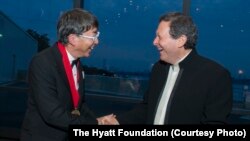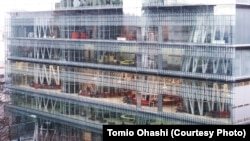BOSTON —
For the second consecutive year, an Asian has won architecture's top award.
Japanese architect Toyo Ito is the newest recipient of the Pritzker Prize, considered to be the “Nobel Prize” of architecture. Ito traveled from Tokyo to receive the award at a recent ceremony at the John F. Kennedy Presidential Library and Museum in Boston, Massachusetts.
Last year, Wang Shu of China won the prestigious award.
“I’m very much honored and surprised,” Ito said.
Observers had been predicting for some time that the 72-year-old architect would be selected one day for his profession’s highest honor. “I understand that this always happens without your expectation, and it depends on how the jury members consider that year’s highlights, so I understand it’s worth the wait,” he said.
One of the 2013 jury members was U.S. Supreme Court Justice Stephen Breyer, an architecture buff who helped with the design and construction of Boston’s federal courthouse.
“[Ito’s] a very important architect throughout the world, he has built all kinds of buildings throughout his career, including quite a few public buildings,” Justice Breyer said. “He spends a great deal of time thinking about them, and they have been successful; they invite the public in, they have an atmosphere of calm, of light, space and it is attractive space.”
Ito was born in 1941 to Japanese parents in what is now Seoul, South Korea. He was educated in Tokyo, and opened his own architectural practice there in 1971. His prominent buildings include Municipal Funeral Hall in Gifu, Japan, the 2002 Serpentine Gallery Pavilion in London, and his personal favorite, the Sendai Mediatheque Library, which survived Japan’s 2011 earthquake.
The transparent library building is composed of structural tubes that support the floors, and is designed to withstand earthquakes. “It took me six years to develop,” said Ito. “At the beginning we had a lot of resistance from the neighbors, but in the end, when it was completed, everybody received it very favorably and everybody enjoyed the building, which is quite a happy thing for me.”
A dramatic video shot in the Sendai Mediatheque during the 2011 earthquake shows the building swaying, but remaining intact. The architect says the structure has a special technological system, designed to withstand temblors. While suffering some damage, the building reopened two months after the earthquake. “I was impressed by the people’s enthusiasm and passion for reopening the facility as soon as possible,” he said.
Japan’s recurring earthquakes have forced architects to prepare for them, according to Ito.
“After the great earthquake in the Hanshin area [in 1995], Japanese buildings have been improving in terms of earthquake resistance structure, so in that sense in Tohoku [the 2011 earthquake] hardly any of the buildings went down, which means the earthquake resistance technologies have improved,” he said. “But as far as the tsunami is concerned, it’s still very difficult to be prepared for such disasters.”
Tom Pritzker, president of the Hyatt Foundation which funds the prizes, was not on the jury. But he is impressed by Ito’s efforts to assist those affected by the 2011 disaster.
“What Mr. Ito did, post-tsunami, and post-earthquake, in working with housing for the displaced, as well as what he’s done on some of his grand buildings, demonstrate to me a flexibility and an agility to work on projects of variety of scales and with different needs,” said Pritzker.
Pritzker believes the awards draw much-needed attention to the profession. “It sort of blends art with practicality,” he said. “The people who emerge as Pritzker laureates are very deep thinkers, and active doers, and they’re fun people as well, so from a personal point of view it’s quite fulfilling.”
Ito said being named the second consecutive Pritzker Prize winner from Asia a sign of Asia’s growing economic clout, which in turn boosts construction and the need for architects. And he said he believes Asian architecture increasingly is showing its own identity.
“In Japan, for more than 100 years, we’ve been importing the technology and architects, basically, from Western countries, we always try to make Western architecture an example,” he said. “However, going forward, we like to make architecture which is more open to nature.”
Justice Breyer, who served on the previous jury which selected Shu, says it seems Asia is becoming a new center for architecture.
“They’re building things,” Breyer said. “And when they’re building things all over in China, in Japan, in Asia, maybe that reflects the economic boom, the technology boom, you’d have to ask others on that, but since a lot of architectural work is going on there, it’s not surprising at all to me that a lot of architects are interested in the buildings that go up there.”
For his part, Ito believes architects should never lose sight of their humanity. “Young architects are chasing fashionable architecture, and they are following only the expression," he said. “I always say to young people, think to whom architecture should be created.”
Noting that "architecture is very restrictive, and people are confined by a lot of restrictions," Ito was asked what an architect's goal should be. "To get freedom,” he said.
Japanese architect Toyo Ito is the newest recipient of the Pritzker Prize, considered to be the “Nobel Prize” of architecture. Ito traveled from Tokyo to receive the award at a recent ceremony at the John F. Kennedy Presidential Library and Museum in Boston, Massachusetts.
Last year, Wang Shu of China won the prestigious award.
“I’m very much honored and surprised,” Ito said.
Observers had been predicting for some time that the 72-year-old architect would be selected one day for his profession’s highest honor. “I understand that this always happens without your expectation, and it depends on how the jury members consider that year’s highlights, so I understand it’s worth the wait,” he said.
One of the 2013 jury members was U.S. Supreme Court Justice Stephen Breyer, an architecture buff who helped with the design and construction of Boston’s federal courthouse.
“[Ito’s] a very important architect throughout the world, he has built all kinds of buildings throughout his career, including quite a few public buildings,” Justice Breyer said. “He spends a great deal of time thinking about them, and they have been successful; they invite the public in, they have an atmosphere of calm, of light, space and it is attractive space.”
Ito was born in 1941 to Japanese parents in what is now Seoul, South Korea. He was educated in Tokyo, and opened his own architectural practice there in 1971. His prominent buildings include Municipal Funeral Hall in Gifu, Japan, the 2002 Serpentine Gallery Pavilion in London, and his personal favorite, the Sendai Mediatheque Library, which survived Japan’s 2011 earthquake.
The transparent library building is composed of structural tubes that support the floors, and is designed to withstand earthquakes. “It took me six years to develop,” said Ito. “At the beginning we had a lot of resistance from the neighbors, but in the end, when it was completed, everybody received it very favorably and everybody enjoyed the building, which is quite a happy thing for me.”
A dramatic video shot in the Sendai Mediatheque during the 2011 earthquake shows the building swaying, but remaining intact. The architect says the structure has a special technological system, designed to withstand temblors. While suffering some damage, the building reopened two months after the earthquake. “I was impressed by the people’s enthusiasm and passion for reopening the facility as soon as possible,” he said.
Japan’s recurring earthquakes have forced architects to prepare for them, according to Ito.
“After the great earthquake in the Hanshin area [in 1995], Japanese buildings have been improving in terms of earthquake resistance structure, so in that sense in Tohoku [the 2011 earthquake] hardly any of the buildings went down, which means the earthquake resistance technologies have improved,” he said. “But as far as the tsunami is concerned, it’s still very difficult to be prepared for such disasters.”
Tom Pritzker, president of the Hyatt Foundation which funds the prizes, was not on the jury. But he is impressed by Ito’s efforts to assist those affected by the 2011 disaster.
“What Mr. Ito did, post-tsunami, and post-earthquake, in working with housing for the displaced, as well as what he’s done on some of his grand buildings, demonstrate to me a flexibility and an agility to work on projects of variety of scales and with different needs,” said Pritzker.
Pritzker believes the awards draw much-needed attention to the profession. “It sort of blends art with practicality,” he said. “The people who emerge as Pritzker laureates are very deep thinkers, and active doers, and they’re fun people as well, so from a personal point of view it’s quite fulfilling.”
Ito said being named the second consecutive Pritzker Prize winner from Asia a sign of Asia’s growing economic clout, which in turn boosts construction and the need for architects. And he said he believes Asian architecture increasingly is showing its own identity.
“In Japan, for more than 100 years, we’ve been importing the technology and architects, basically, from Western countries, we always try to make Western architecture an example,” he said. “However, going forward, we like to make architecture which is more open to nature.”
Justice Breyer, who served on the previous jury which selected Shu, says it seems Asia is becoming a new center for architecture.
“They’re building things,” Breyer said. “And when they’re building things all over in China, in Japan, in Asia, maybe that reflects the economic boom, the technology boom, you’d have to ask others on that, but since a lot of architectural work is going on there, it’s not surprising at all to me that a lot of architects are interested in the buildings that go up there.”
For his part, Ito believes architects should never lose sight of their humanity. “Young architects are chasing fashionable architecture, and they are following only the expression," he said. “I always say to young people, think to whom architecture should be created.”
Noting that "architecture is very restrictive, and people are confined by a lot of restrictions," Ito was asked what an architect's goal should be. "To get freedom,” he said.








